How does SpringBoot perform parameter verification?
Introduction
In daily interface development, in order to prevent illegal parameters from affecting the business, it is often necessary to verify the parameters of the interface. For example, when logging in, it is necessary to verify whether the user name and password are empty. When adding a user, verify whether the format of the user's email address and mobile phone number is correct. It would be too cumbersome to rely on code to verify interface parameters one by one, and the readability of the code would be extremely poor.
ValidatorThe framework is designed to solve the problem of developers writing less code during development and improving development efficiency; Validator is specially used to verify interface parameters, such as common required verification, email Format verification, the username must be between 6 and 12, etc.
Next let’s take a look at how to integrate the parameter verification framework in SpringbBoot.
1.Integrated parameter verification in SpringBoot
1.1Introducing dependencies
<dependency> <groupId>org.springframework.boot</groupId> <artifactId>spring-boot-starter-validation</artifactId> </dependency>
1.2Define parameter entity classes
package com.didiplus.modules.sys.domain;
import io.swagger.annotations.ApiModel;
import io.swagger.annotations.ApiModelProperty;
import lombok.Data;
import javax.validation.constraints.Email;
import javax.validation.constraints.NotBlank;
import javax.validation.constraints.NotEmpty;
/**
* Author: didiplus
* Email: 972479352@qq.com
* CreateTime: 2022/4/25
* Desc: 字典类型领域模型
*/
@Data
@ApiModel(value = "字典类型")
public class SysDictType {
@ApiModelProperty("ID")
private String id;
@NotBlank(message = "字典名称必填项")
@ApiModelProperty(value = "字典名称",example = "用户ID")
private String typeName;
@NotBlank(message = "字典编码不能为空")
@ApiModelProperty(value = "字典编码")
private String typeCode;
@Email(message = "请填写正确的邮箱地址")
@ApiModelProperty(value = "字典编码")
private String email;
@ApiModelProperty(value = "字典描述")
private String description;
@NotBlank(message = "字典状态不能为空")
@ApiModelProperty(value = "字典状态")
private String enable;
}Common constraint annotations are as follows:
| Annotation | Function |
|---|---|
| @AssertFalse | can be null, if not null Must be false |
| @AssertTrue | can be null, if not null it must be true |
| @DecimalMax | The setting cannot exceed the maximum value |
| @DecimalMin | The setting cannot exceed the minimum value |
| @Digits | The setting must be a number and the number of integer digits and decimal digits must be within the specified range |
| @Future | The date must be within the current date The future |
| @Past | date must be in the past |
| @Max | max of the current date This maximum value must not be exceeded |
| @Min | The maximum must not be less than this minimum value |
| @NotNull | Cannot be null, can be empty |
| @Null | Must be null |
| @Pattern | Must satisfy the specified regular expression |
| @Size | The size() value of collections, arrays, maps, etc. must be within the specified range |
| Must be in email format | |
| @Length | The length must be within the specified range |
| @NotBlank | The string cannot be null, and the string after trim() cannot be equal to "" |
| @NotEmpty | Cannot be null, size() of collections, arrays, maps, etc. cannot be 0; string trim() can be equal to "" |
| @Range | The value must be Within the specified range |
| @URL | must be a URL |
1.3定义校验类进行测试
package com.didiplus.modules.sys.controller;
import com.didiplus.modules.sys.domain.SysDictType;
import io.swagger.annotations.Api;
import io.swagger.annotations.ApiOperation;
import io.swagger.v3.oas.annotations.parameters.RequestBody;
import org.springframework.validation.annotation.Validated;
import org.springframework.web.bind.annotation.PostMapping;
import org.springframework.web.bind.annotation.PutMapping;
import org.springframework.web.bind.annotation.RequestMapping;
import org.springframework.web.bind.annotation.RestController;
/**
* Author: didiplus
* Email: 972479352@qq.com
* CreateTime: 2022/4/25
* Desc: 数据字典控制器
*/
@RestController
@Api(tags = "数据字典")
@RequestMapping("/api/sys/dictType")
public class SysDictTypeController {
@ApiOperation("字典添加")
@PostMapping("/add")
public SysDictType add(@Validated @RequestBody SysDictType sysDictType) {
return sysDictType;
}
@ApiOperation("字典修改")
@PutMapping("/edit")
public SysDictType edit(@Validated @RequestBody SysDictType sysDictType) {
return sysDictType;
}
}这里我们先定义两个方法add,edit,都是使用了 @RequestBody注解,用于接受前端发送的json数据。
1.4打开接口文档模拟提交数据

通过接口文档看到前三个字段都是必填项。
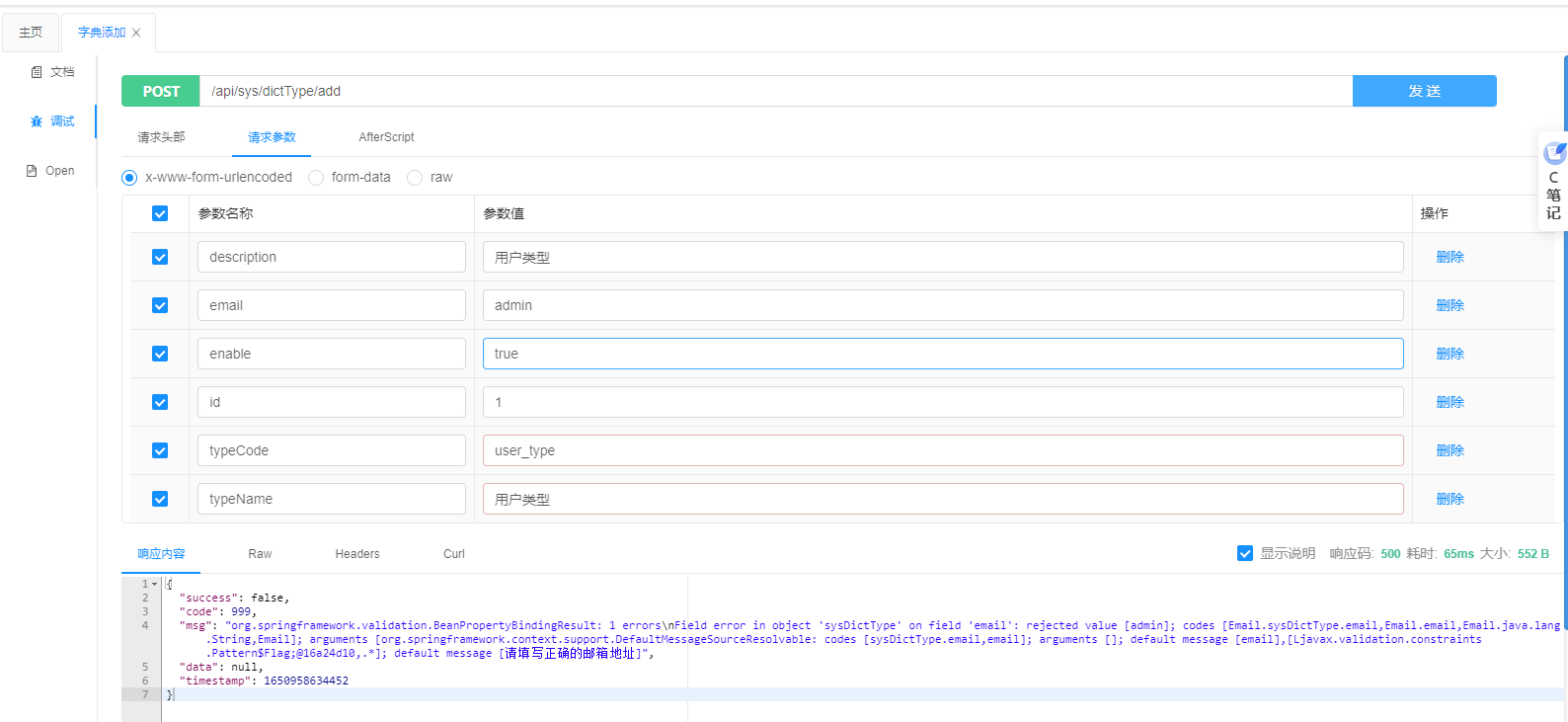
由于email的格式不对就被拦截了,提示是因为邮箱地址不对。
2.参数异常加入全局异常处理器
虽然我们之前定义了全局异常拦截器,也看到了拦截器确实生效了,但是Validator校验框架返回的错误提示太臃肿了,不便于阅读,为了方便前端提示,我们需要将其简化一下。
直接修改之前定义的 RestExceptionHandler,单独拦截参数校验的三个异常:
javax.validation.ConstraintViolationException
org.springframework.validation.BindException
org.springframework.web.bind.MethodArgumentNotValidException
代码如下:
package com.didiplus.common.web.response.Handler;
import com.didiplus.common.web.response.Result;
import org.springframework.http.HttpStatus;
import org.springframework.http.ResponseEntity;
import org.springframework.validation.BindException;
import org.springframework.validation.ObjectError;
import org.springframework.web.bind.MethodArgumentNotValidException;
import org.springframework.web.bind.annotation.ExceptionHandler;
import org.springframework.web.bind.annotation.RestControllerAdvice;
import javax.validation.ConstraintViolation;
import javax.validation.ConstraintViolationException;
import javax.validation.ValidationException;
import java.util.stream.Collectors;
/**
* Author: didiplus
* Email: 972479352@qq.com
* CreateTime: 2022/4/24
* Desc: 默认全局异常处理。
*/
@RestControllerAdvice
public class RestExceptionHandler {
/**
* 默认全局异常处理。
* @param e the e
* @return ResultData
*/
@ExceptionHandler(value = {BindException.class, ValidationException.class, MethodArgumentNotValidException.class})
public ResponseEntity<Result<String>> handleValidatedException(Exception e) {
Result<String> result = null;
if (e instanceof MethodArgumentNotValidException) {
MethodArgumentNotValidException ex =(MethodArgumentNotValidException) e;
result = Result.failure(HttpStatus.BAD_REQUEST.value(),
ex.getBindingResult().getAllErrors().stream()
.map(ObjectError::getDefaultMessage)
.collect(Collectors.joining(";"))
);
} else if (e instanceof ConstraintViolationException){
ConstraintViolationException ex = (ConstraintViolationException) e;
result = Result.failure(HttpStatus.BAD_REQUEST.value(),
ex.getConstraintViolations().stream()
.map(ConstraintViolation::getMessage)
.collect(Collectors.joining(";"))
);
}else if (e instanceof BindException) {
BindException ex = (BindException ) e;
result = Result.failure(HttpStatus.BAD_REQUEST.value(),
ex.getAllErrors().stream()
.map(ObjectError::getDefaultMessage)
.collect(Collectors.joining(";"))
);
}
return new ResponseEntity<>(result,HttpStatus.BAD_REQUEST);
}
}美化之后错误信息提示更加友好
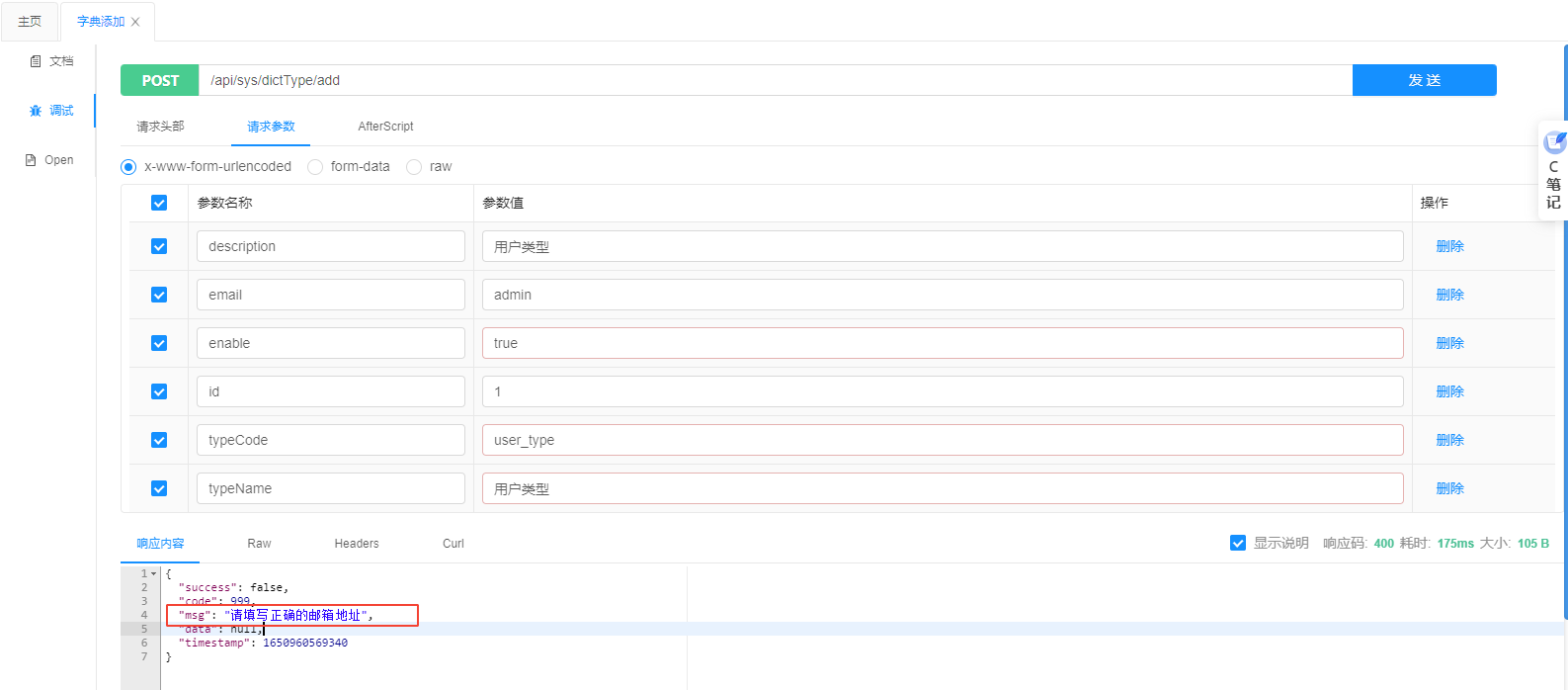
3.自定义参数校验
虽然Spring Validation 提供的注解基本上够用,但是面对复杂的定义,我们还是需要自己定义相关注解来实现自动校验。
比如上面实体类中添加的sex性别属性,只允许前端传递传 M,F 这2个枚举值,如何实现呢?
3.1创建自定义注解
package com.didiplus.common.annotation;
import javax.validation.Constraint;
import javax.validation.Payload;
import java.lang.annotation.Documented;
import java.lang.annotation.Repeatable;
import java.lang.annotation.Retention;
import java.lang.annotation.Target;
import static java.lang.annotation.ElementType.*;
import static java.lang.annotation.RetentionPolicy.RUNTIME;
/**
* Author: didiplus
* Email: 972479352@qq.com
* CreateTime: 2022/4/26
* Desc:
*/
@Target({METHOD, FIELD, ANNOTATION_TYPE, CONSTRUCTOR, PARAMETER, TYPE_USE})
@Retention(RUNTIME)
@Repeatable(EnumString.List.class)
@Documented
@Constraint(validatedBy = EnumStringValidator.class)//标明由哪个类执行校验逻辑
public @interface EnumString {
String message() default "value not in enum values.";
Class<?>[] groups() default {};
Class<? extends Payload>[] palyload() default {};
/**
* @return date must in this value array
*/
String[] value();
/**
* Defines several {@link EnumString} annotations on the same element.
*
* @see EnumString
*/
@Target({METHOD, FIELD, ANNOTATION_TYPE, CONSTRUCTOR, PARAMETER, TYPE_USE})
@Retention(RUNTIME)
@Documented
@interface List {
EnumString[] value();
}
}3.2自定义校验逻辑
package com.didiplus.common.annotation;
import javax.validation.ConstraintValidator;
import javax.validation.ConstraintValidatorContext;
import java.util.Arrays;
import java.util.List;
/**
* Author: didiplus
* Email: 972479352@qq.com
* CreateTime: 2022/4/26
* Desc:
*/
public class EnumStringValidator implements ConstraintValidator<EnumString,String> {
private List<String> enumStringList;
@Override
public void initialize(EnumString constraintAnnotation) {
enumStringList = Arrays.asList(constraintAnnotation.value());
}
@Override
public boolean isValid(String value, ConstraintValidatorContext constraintValidatorContext) {
if(value == null) {
return true;
}
return enumStringList.contains(value);
}
}3.3在字段上增加注解
@ApiModelProperty(value = "性别")
@EnumString(value = {"F","M"}, message="性别只允许为F或M")
private String sex;3.4体验效果
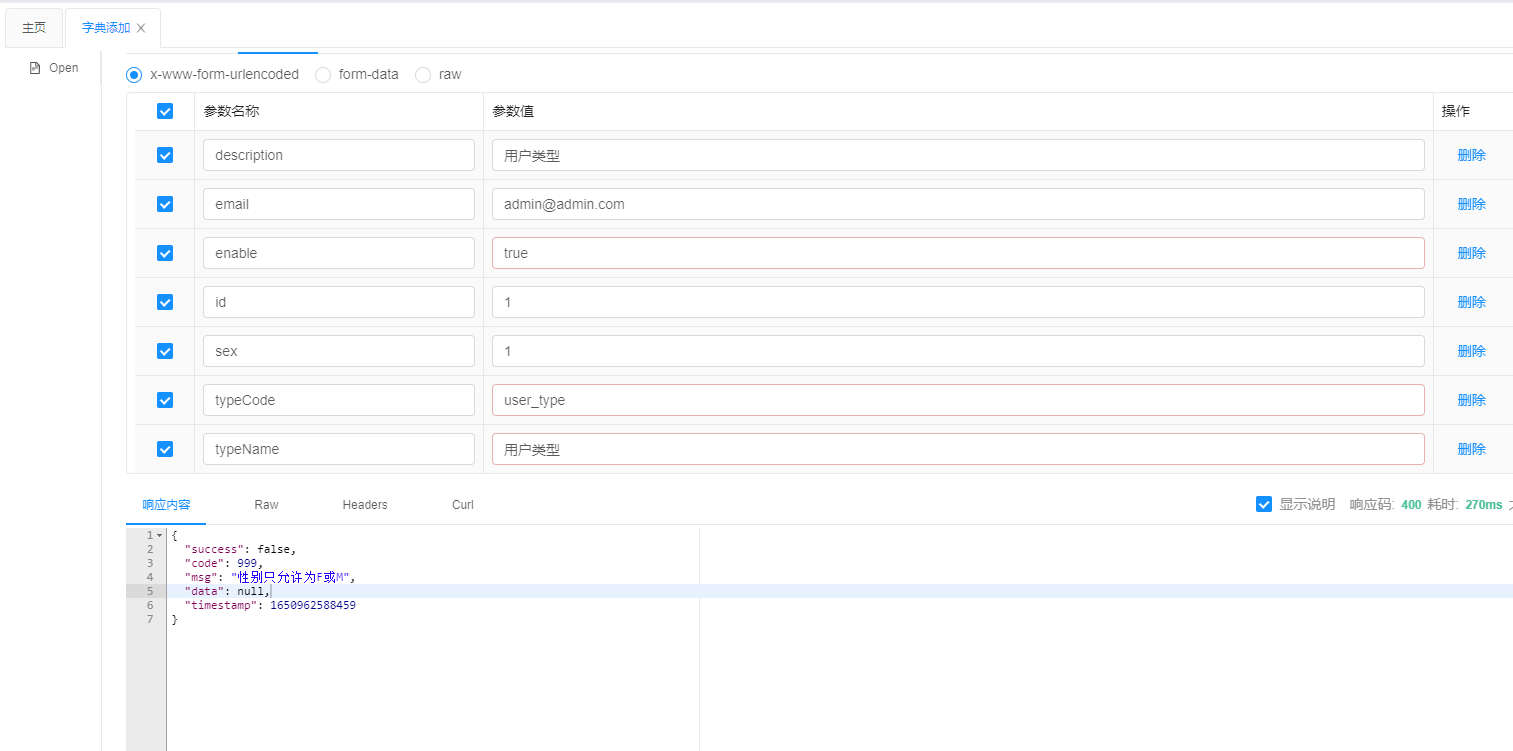
4.分组校验
一个对象在新增的时候某些字段是必填,在更新是有非必填。如上面的 SysDictType中id 属性在新增操作时都是必填。 面对这种场景你会怎么处理呢?
其实 Validator校验框架已经考虑到了这种场景并且提供了解决方案,就是分组校验。 要使用分组校验,只需要三个步骤:
4.1定义分组接口
package com.didiplus.common.base;
import javax.validation.groups.Default;
/**
* Author: didiplus
* Email: 972479352@qq.com
* CreateTime: 2022/4/26
* Desc:
*/
public interface ValidGroup extends Default {
interface Crud extends ValidGroup{
interface Create extends Crud{
}
interface Update extends Crud{
}
interface Query extends Crud{
}
interface Delete extends Crud{
}
}
}4.2在模型中给参数分配分组
@Null(groups = ValidGroup.Crud.Create.class)
@NotNull(groups = ValidGroup.Crud.Update.class,message = "字典ID不能为空")
@ApiModelProperty("ID")
private String id;4.3体现效果
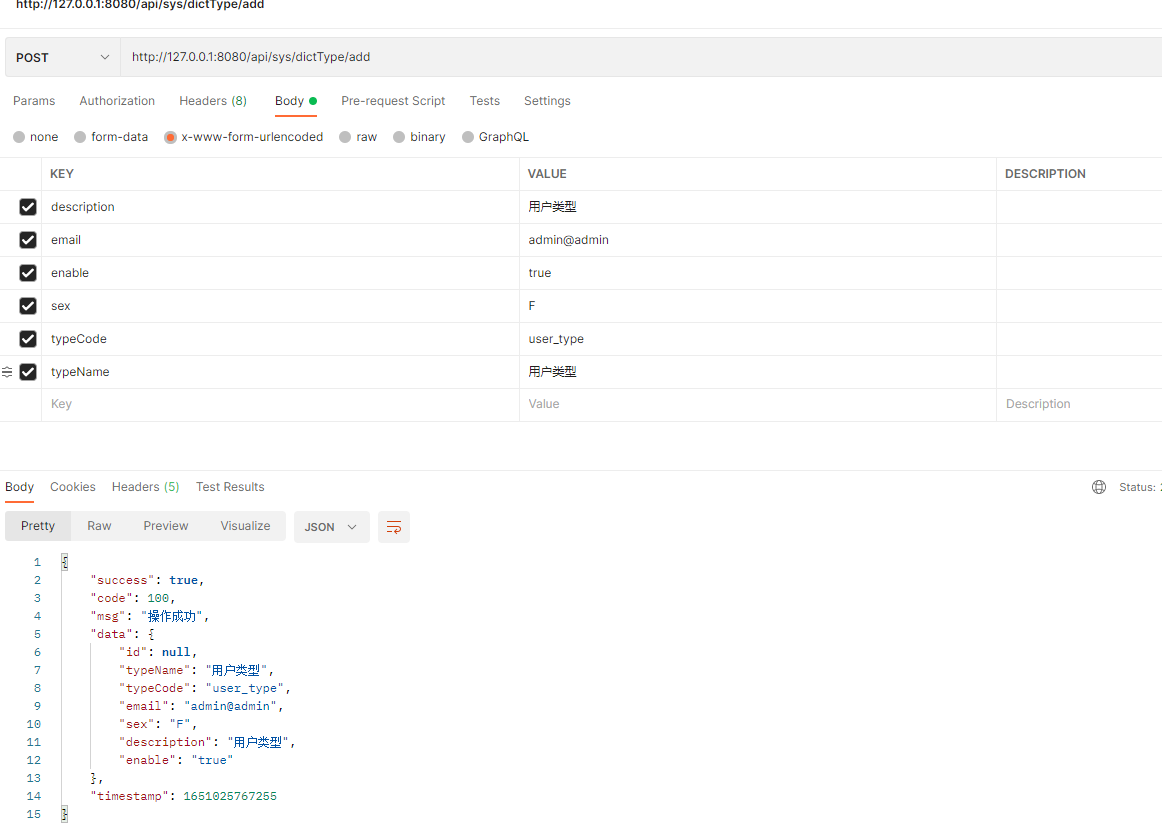
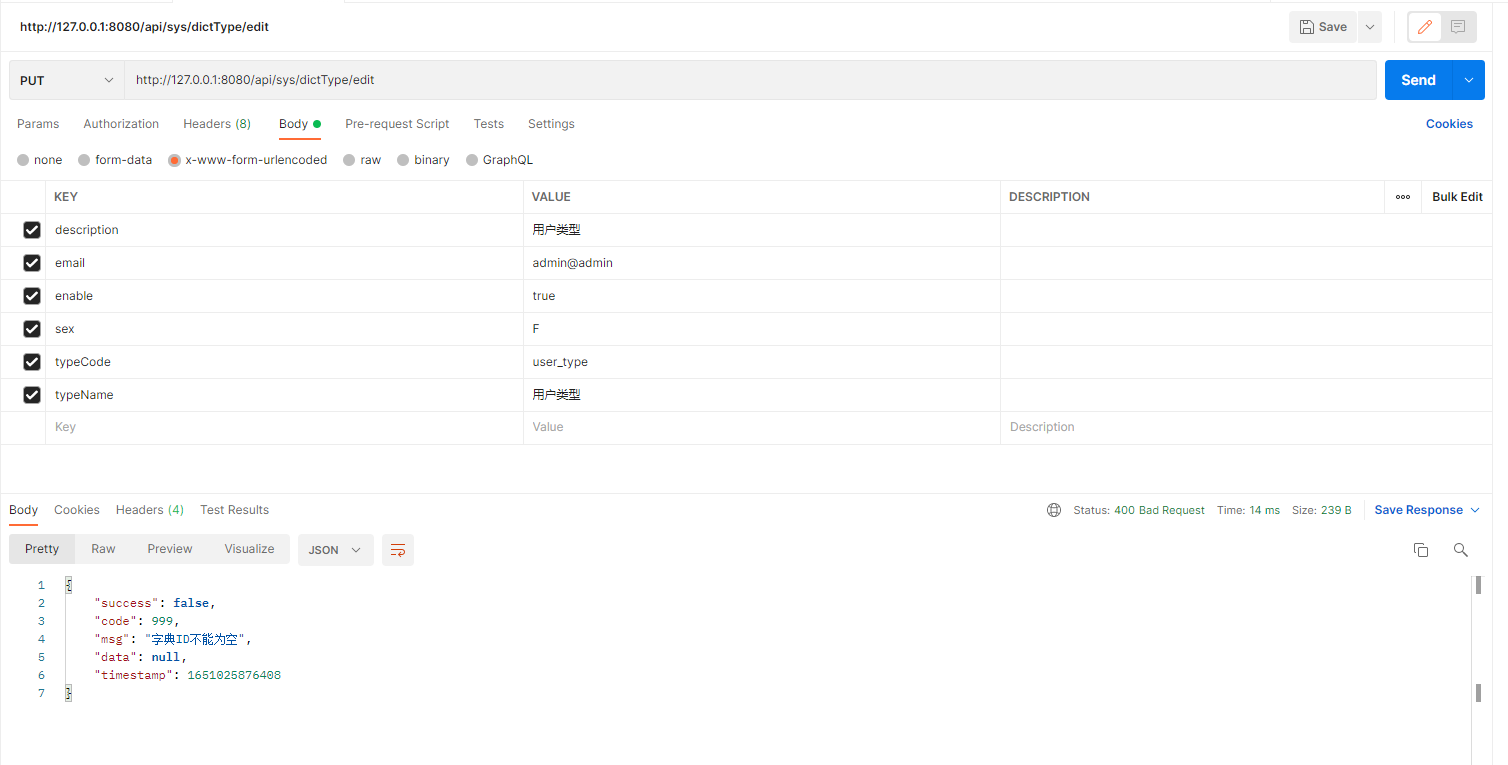
The above is the detailed content of How does SpringBoot perform parameter verification?. For more information, please follow other related articles on the PHP Chinese website!

Hot AI Tools

Undresser.AI Undress
AI-powered app for creating realistic nude photos

AI Clothes Remover
Online AI tool for removing clothes from photos.

Undress AI Tool
Undress images for free

Clothoff.io
AI clothes remover

AI Hentai Generator
Generate AI Hentai for free.

Hot Article

Hot Tools

Notepad++7.3.1
Easy-to-use and free code editor

SublimeText3 Chinese version
Chinese version, very easy to use

Zend Studio 13.0.1
Powerful PHP integrated development environment

Dreamweaver CS6
Visual web development tools

SublimeText3 Mac version
God-level code editing software (SublimeText3)

Hot Topics
 1359
1359
 52
52
 How Springboot integrates Jasypt to implement configuration file encryption
Jun 01, 2023 am 08:55 AM
How Springboot integrates Jasypt to implement configuration file encryption
Jun 01, 2023 am 08:55 AM
Introduction to Jasypt Jasypt is a java library that allows a developer to add basic encryption functionality to his/her project with minimal effort and does not require a deep understanding of how encryption works. High security for one-way and two-way encryption. , standards-based encryption technology. Encrypt passwords, text, numbers, binaries... Suitable for integration into Spring-based applications, open API, for use with any JCE provider... Add the following dependency: com.github.ulisesbocchiojasypt-spring-boot-starter2. 1.1Jasypt benefits protect our system security. Even if the code is leaked, the data source can be guaranteed.
 How SpringBoot integrates Redisson to implement delay queue
May 30, 2023 pm 02:40 PM
How SpringBoot integrates Redisson to implement delay queue
May 30, 2023 pm 02:40 PM
Usage scenario 1. The order was placed successfully but the payment was not made within 30 minutes. The payment timed out and the order was automatically canceled. 2. The order was signed and no evaluation was conducted for 7 days after signing. If the order times out and is not evaluated, the system defaults to a positive rating. 3. The order is placed successfully. If the merchant does not receive the order for 5 minutes, the order is cancelled. 4. The delivery times out, and push SMS reminder... For scenarios with long delays and low real-time performance, we can Use task scheduling to perform regular polling processing. For example: xxl-job Today we will pick
 How to use Redis to implement distributed locks in SpringBoot
Jun 03, 2023 am 08:16 AM
How to use Redis to implement distributed locks in SpringBoot
Jun 03, 2023 am 08:16 AM
1. Redis implements distributed lock principle and why distributed locks are needed. Before talking about distributed locks, it is necessary to explain why distributed locks are needed. The opposite of distributed locks is stand-alone locks. When we write multi-threaded programs, we avoid data problems caused by operating a shared variable at the same time. We usually use a lock to mutually exclude the shared variables to ensure the correctness of the shared variables. Its scope of use is in the same process. If there are multiple processes that need to operate a shared resource at the same time, how can they be mutually exclusive? Today's business applications are usually microservice architecture, which also means that one application will deploy multiple processes. If multiple processes need to modify the same row of records in MySQL, in order to avoid dirty data caused by out-of-order operations, distribution needs to be introduced at this time. The style is locked. Want to achieve points
 How to solve the problem that springboot cannot access the file after reading it into a jar package
Jun 03, 2023 pm 04:38 PM
How to solve the problem that springboot cannot access the file after reading it into a jar package
Jun 03, 2023 pm 04:38 PM
Springboot reads the file, but cannot access the latest development after packaging it into a jar package. There is a situation where springboot cannot read the file after packaging it into a jar package. The reason is that after packaging, the virtual path of the file is invalid and can only be accessed through the stream. Read. The file is under resources publicvoidtest(){Listnames=newArrayList();InputStreamReaderread=null;try{ClassPathResourceresource=newClassPathResource("name.txt");Input
 Comparison and difference analysis between SpringBoot and SpringMVC
Dec 29, 2023 am 11:02 AM
Comparison and difference analysis between SpringBoot and SpringMVC
Dec 29, 2023 am 11:02 AM
SpringBoot and SpringMVC are both commonly used frameworks in Java development, but there are some obvious differences between them. This article will explore the features and uses of these two frameworks and compare their differences. First, let's learn about SpringBoot. SpringBoot was developed by the Pivotal team to simplify the creation and deployment of applications based on the Spring framework. It provides a fast, lightweight way to build stand-alone, executable
 How to implement Springboot+Mybatis-plus without using SQL statements to add multiple tables
Jun 02, 2023 am 11:07 AM
How to implement Springboot+Mybatis-plus without using SQL statements to add multiple tables
Jun 02, 2023 am 11:07 AM
When Springboot+Mybatis-plus does not use SQL statements to perform multi-table adding operations, the problems I encountered are decomposed by simulating thinking in the test environment: Create a BrandDTO object with parameters to simulate passing parameters to the background. We all know that it is extremely difficult to perform multi-table operations in Mybatis-plus. If you do not use tools such as Mybatis-plus-join, you can only configure the corresponding Mapper.xml file and configure The smelly and long ResultMap, and then write the corresponding sql statement. Although this method seems cumbersome, it is highly flexible and allows us to
 How SpringBoot customizes Redis to implement cache serialization
Jun 03, 2023 am 11:32 AM
How SpringBoot customizes Redis to implement cache serialization
Jun 03, 2023 am 11:32 AM
1. Customize RedisTemplate1.1, RedisAPI default serialization mechanism. The API-based Redis cache implementation uses the RedisTemplate template for data caching operations. Here, open the RedisTemplate class and view the source code information of the class. publicclassRedisTemplateextendsRedisAccessorimplementsRedisOperations, BeanClassLoaderAware{//Declare key, Various serialization methods of value, the initial value is empty @NullableprivateRedisSe
 How to get the value in application.yml in springboot
Jun 03, 2023 pm 06:43 PM
How to get the value in application.yml in springboot
Jun 03, 2023 pm 06:43 PM
In projects, some configuration information is often needed. This information may have different configurations in the test environment and the production environment, and may need to be modified later based on actual business conditions. We cannot hard-code these configurations in the code. It is best to write them in the configuration file. For example, you can write this information in the application.yml file. So, how to get or use this address in the code? There are 2 methods. Method 1: We can get the value corresponding to the key in the configuration file (application.yml) through the ${key} annotated with @Value. This method is suitable for situations where there are relatively few microservices. Method 2: In actual projects, When business is complicated, logic




